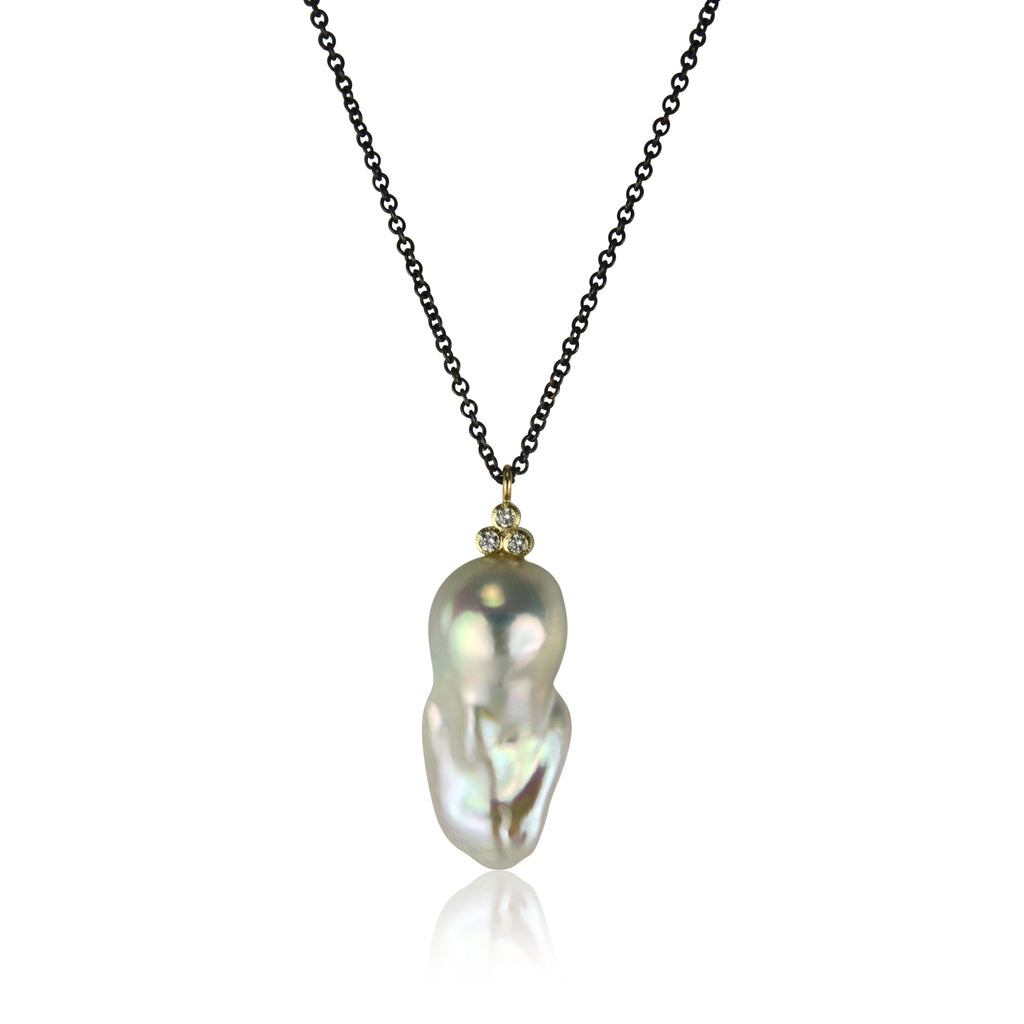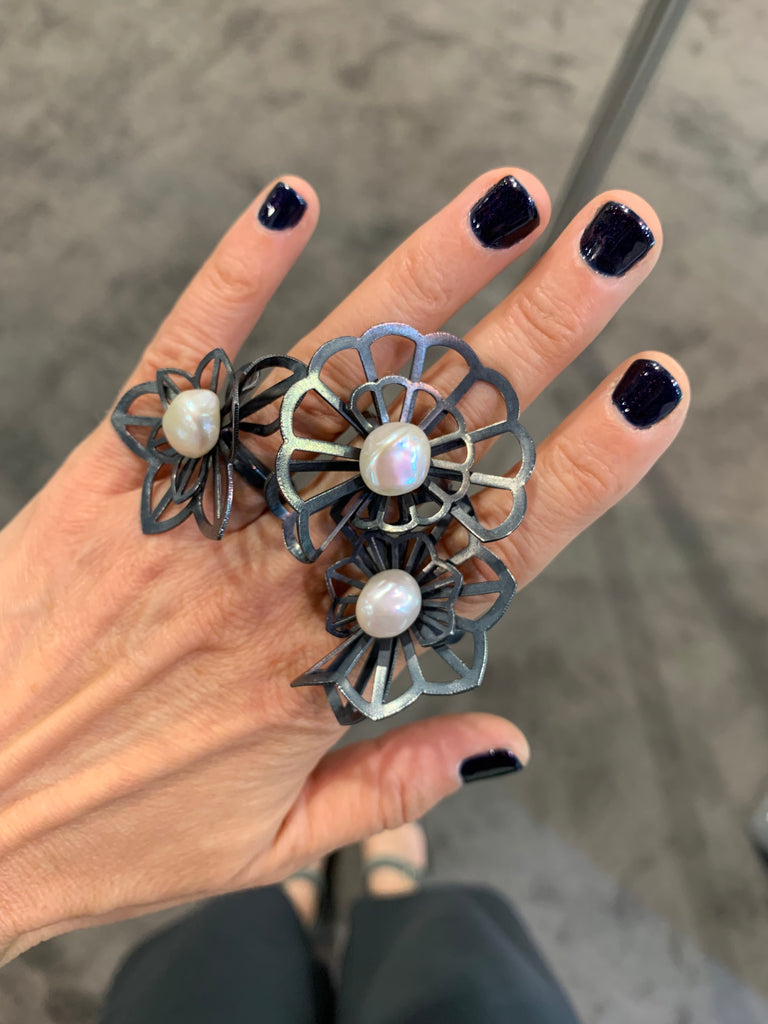Confession: Before I created a collection for the pearl-themed show at Aaron Faber in spring of 2018, I hadn't considered pairing them with my Origami designs. I used them occasionally for custom pieces, but hadn't given much thought to how well they would "play" with the new work. But now, I’m a convert! It turns out the curves and natural iridescence of pearls create a perfect juxtaposition with my clean lines and organic shapes. (The Saul Bell Award committee agreed!)
Since I’m a big pearl fan now, I thought I’d dig into how they’re formed, the differences between various types, and a few tips for pearl care. And this post is especially timely because pearls are June's birthstone! So read on ... it turns out that pearls are as fascinating as they are gorgeous.
How pearls are formed
You might know this one, but for those who don’t, brace yourselves for an interesting bit of information: natural pearls form inside of a mollusk - an oyster, mussel, or clam. They begin to take shape when some sort of irritant works its way inside of the shell, and the living animal secretes a liquid called nacre to surround the invader. (This protects the animal's delicate tissue from the foreign object.) Layer on layer coats the irritant—usually some sort of tiny parasite—and eventually, a pearl is formed as the nacre accumulates and hardens.[1] It can take two to four YEARS for a single pearl to form naturally!
Cultured pearls are formed through the same process, except that the irritant is a carefully implanted bead or piece of tissue.[2] Since it’s SO difficult to find pearls that have formed without any human interference, nearly all pearls on the modern market are cultured. Truly natural pearls are both exceptionally rare and wildly expensive.[3]
Pearl-rich places and how they affect the gems
You might think that since pearl farmers are in charge of coaxing various mollusks to coat beads with nacre, all cultured pearls would look the same. Not so! You’ve likely heard the terms Akoya and South Sea thrown around when discussing pearls, and there are many other pearl types that describe various colors and culturing locations.
Akoya pearls are cultured in Japan, and are considered by many to be the most lustrous and valuable. White South Sea cultured pearls are farmed from tropical or semi-tropical oysters (usually the Pinctada Maxima oyster) in Australia, Mynamar, Indonesia, and other Pacific countries. They tend to be quite large, making them coveted and pricey.[4] South Sea black cultured pearls hail only from French Polynesia, and are formed inside of black lip oysters who lend them their dark shade.[5] Golden South Sea pearls—as you might’ve guessed—are grown in the gold-lip variety of the Pinctada Maxima, and the deeper their color the more valuable they become.[6]
 |
Here are a couple of pieces custom designed for a client who brought me some Tahitian black pearls. I absolutely loved the look of black on black, so I picked up some more black pearls when I was in Tucson to use in future designs. I'm not sure what I'm going to make with them yet ... but stay tuned! |
Now, all of the pearls we’ve covered so far have been saltwater pearls, but there are freshwater varieties, too! Freshwater pearls are easier and quicker to cultivate than saltwater, and they’re farmed from freshwater mussels rather than oysters. They’re cultured in Japan, China and the United States, and are abundant enough to make them affordable.[7]
 |
Most of the pearls I use are Chinese freshwater pearls. All of the pieces above feature them! |
Freshwater pearls aren’t all perfectly round, and can come in a variety of interesting shapes.
 |
Pearl farmers can change the shape of the pearl by changing the shape of the nucleus of the (the bead or tissue at the center of the nacre). I absolutely love this Baroque shaped pearl! |
Finally, we have Keshi pearls. A true Keshi pearl has no "nucleus" - it is entirely made of nacre. This allows them to form in a variety of irregular shapes.[7] Another fun fact: Keshi pearls can form in either saltwater or freshwater mollusks.[8]
 |
These fun statement rings all feature "keshi" shaped pearls - although they aren't true Keshis (with no nucuelus). But regardless of how they were formed, I love the irregular shape when contrasted with the more structured Origami shapes! |
So many pearls to choose from … but wait! There’s more!
Natural vs. dyed pearls
There are many shades that occur naturally in pearls, depending on where they’re grown and the type of mollusk that nurtures them. I love the variety of natural colors, and so I tend not to use dyed pearls. But just in case you’re not satisfied with a range of lovely creams, golds, blues, browns, and grays, pearls can also be dyed. And if a pearl is dyed skillfully the process doesn’t have to impact its value. In fact, sometimes precious Akoya pearls are subtly dyed to give them a rosier glow.[9]
How to care for your pearls
Since pearls are formed organically, they are a little bit fussy to care for and protect. They react to acid, alkaline, and humidity (which is pretty much everything), so you want to keep them away from makeup, lotions, and hairspray. The folks at Mikimoto, a renowned pearl house, recommend putting on your pearls “as a final touch, after applying make-up and styling hair.”[10] If you’ve gotten a bit sweaty while wearing them, wipe down with a soft cloth before returning them to your jewelry box.
All that said, pearls actually do NEED a little bit of moisture. Packing them in an airtight bag or container can ruin them, causing cracks and disintegration. The best way to keep them happy? Wear them! "There is a saying that 'pearls want to be worn,' and it is true!"[11]
Pearls can get scratched, so try to keep them away from brooches, clasps, and sharp objects. Some people like to store them in a protective pouch, but it isn't technically necessary as long as you don't just toss them in with your other jewelry - it's best to give them their own compartment inside your jewelry box.[12]
Pearls are sometimes thought of as classic … to the point of being stuffy. (Your grandma’s jewelry, in other words.) But with the huge variety of colors and shapes available, and the infinite ways they can be incorporated into modern jewelry designs, I think they’re totally timeless. It turns out, pearls are for everyone ... including me!
____________________________
Sources:
[1] https://pearls.com/pages/how-pearls-are-formed
[2] https://www.gia.edu/pearl
[3] https://www.thepearlsource.com/facts-about-pearls/how-are-pearls-made.php
[4, 5, 7] https://www.jewelers.org/education/pearl-buying-guide/pearl-types
[6] https://www.pearlparadise.com/pages/golden-south-sea-information
[8] https://en.wikipedia.org/wiki/Keshi_pearls
[9] https://pearlsinternational.com/pearl-colors-treatment/
[10, 11, 12] https://www.mikimotoamerica.com/pearl-care
